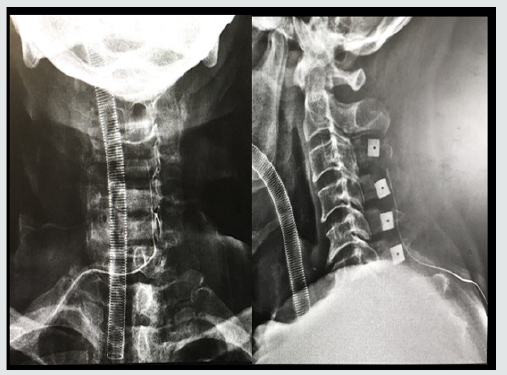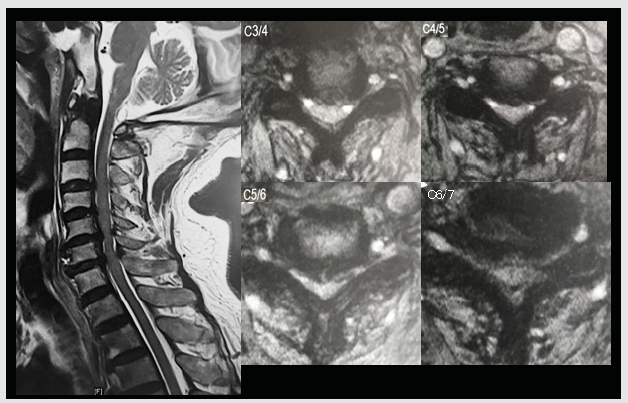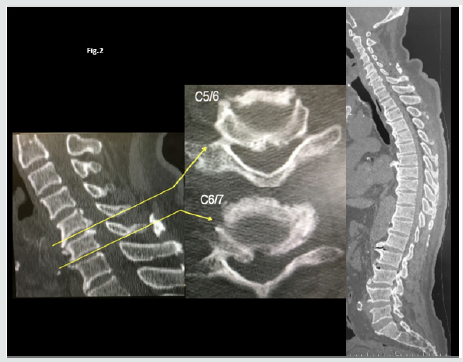Lupine Publishers | Journal of Surgery & Case Studies
Intraoperative spinal cord injury (SCI) is uncommon and the
pathology has not cleared. We report cervical cord injury without
vertebral fracture during a coronary artery bypass operation.
Cervical cord compression (CCC) is compression of the cervical
spinal cord that occurs during the normal course of aging and
may progress into cervical spondylotic myelopathy (CSM), which
can cause neurologic dysfunction. Many people with cervical
cord compression are asymptomatic. However, patients with CCC
are at higher risk of SCI following minor injury. An 85-year-old
woman with asymptomatic cervical cord compression underwent
a coronary artery bypass graft surgery. After the surgery, he
developed tetraplegia. MRI revealed severe spinal cord compression
from C3 to C7 and C5/6 signal change of spinal cord (Figure 1). The
radiograph and CT showed diffuse idiopathic skeletal hyperostosis
and thoracic kyphosis of 55 degree (Figure 2). Cervical SCI after
was diagnosed. After the diagnosis, we underwent laminoplasty
(Figure 3). And he almost completely recovered after surgery.
Follow on Linkedin : https://www.linkedin.com/company/lupinepublishers
Follow on Twitter : https://twitter.com/lupine_online
Case Report
Figure 3: The radiograph and CT showed diffuse idiopathic skeletal hyperostosis and thoracic kyphosis Radiograph after
laminoplasty for cervical spinal cord injury.

Iatrogenic cervical SCI after non spinal surgeries that
requires neck hyperextension is rarely reported, probably due
to underdiagnosis and underreport. In the current aging society,
the prevalence of patients with CCC is expected to increase. In
our population-based magnetic resonance imaging (MRI) study,
the prevalence rate of CCC was 24.4%, and it was higher with
increasing age in both men and women [1]. Among the 15 cases
(including ours) published in the literature [2], most patients had
cervical cord compression and were old men. Eight patients had
undergone coronary artery bypass surgery that requires prolonged
operative time. Only 3 patients had almost complete recovery.
Two patients required tracheostomy for long-term ventilator
support. Two patients died. These cases reiterate the potential risk
of iatrogenic SCI in people with predisposing conditions such as
cervical spondylosis and CCC. Moreover, in this case, the patient had
diffuse idiopathic skeletal hyperostosis and thoracic kyphosis of
55 degree, which can lead inflexibility of spine. The inflexibility of
thoracic spine might cause hyperextension of cervical spine during
the surgery. Surgeries requiring prolonged neck hyperextension
put patients with cervical spondylosis and CCC at risk for SCI. It is
essential to recognize the potential occurrence of iatrogenic SCI
might endanger patients’ lives.
For more Lupine Publishers Open Access Journals Please visit our website:
For more Surgery Journal articles Please Click Here:
To Know More About Open Access Publishers Please Click on Lupine Publishers
Follow on Twitter : https://twitter.com/lupine_online



No comments:
Post a Comment